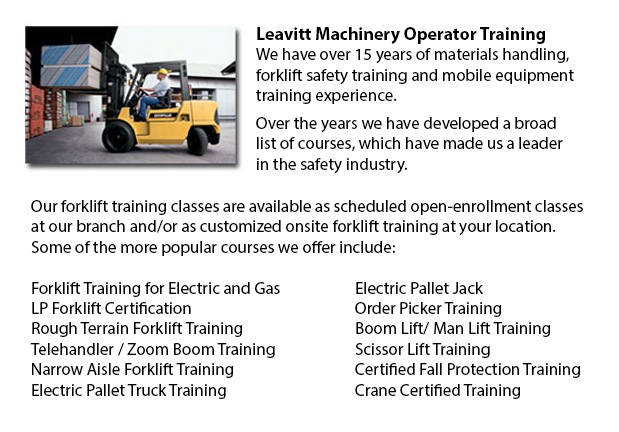
Coquitlam Forklift Training Schools - What Are Covered In Our Forklift Training Schools
If you are searching for work as a forklift operator, our regulatory-compliant forklift training Schools offer exceptional instruction in numerous types and styles of forklifts, classes on pre-shift inspection, fuel kinds and handling of fuels, and safe use of a lift truck. Practical, hands-on training helps participants in acquiring essential operational skills. Course content covers existing rules governing the operation of lift trucks. Our proven forklift Schools are intended to provide training on these kinds of trucks: powered pallet truck, narrow isle forklift and counterbalanced forklift.
Do not lower or raise the fork while the forklift is traveling. A load must not extend over the backrest due to the danger of the load sliding back toward the operator. Inspect for overhead obstructions and ensure there is plenty of clearance prior to lifting a load. Stay away from overhead power lines. Once the load is lifted straight up, tilt it slightly back.
The lift truck is less steady if a load is in a raised position. Make sure that no body ever walks underneath the elevated fork. The operator must not leave the lift truck while the load is lifted.
The forks should be level when handling pallets, and high enough to extend all the way into and below the load. The width of the forks should provide equal weight distribution.
Set the brakes and chock the wheels prior to loading and unloading the truck. The floors must be strong enough to support the combined weight of the forklift and its load. Fixed jacks can be installed to be able to support a semi-trailer that is not coupled to a tractor. The height of the entrance door should clear the forklift height by a minimum of 5 cm. Edges of docks, rail cars and ramps should be marked and avoid them.
-
Coquitlam Crane Certification
Coquitlam Crane Certification - The Crane Certification training program consists of subject matter recommended by industry concerning the safe and efficient operation of cranes. Trainees will be taught the following: how to identify cranes and their... More -
Coquitlam Crane Training Courses
Coquitlam Crane Training Courses - A crane is a kind of equipment designed to move, lift and lower heavy stuff. A crane is usually equipped with a hoist, sheaves, and chains or wire ropes. Cranes are used in the manufacturing, construction and transp... More -
Coquitlam Boom Lift Safety Training
Coquitlam Boom Lift Safey Training - Boom lifts are a kind of elevated work platform or aerial lifting device which are usually used in industry, warehousing and construction. Boom lifts can be utilized in virtually any setting due to their versatili... More -
Coquitlam Boom Lift Training
Coquitlam Boom Lift Training - Aerial platforms or also known as elevated work platforms are devices which allow workers to carry out duties and tasks at elevated heights that would not be otherwise reachable. There are different aerial lifts availab... More -
Coquitlam Forklift Certification Schools
Coquitlam Forklift Certification Schools - Forklift Certification is mandatory within North America. Hence, forklift training programs are important both for businesses and for people looking for jobs in industries as operators of forklifts. Forklift... More -
Coquitlam Wheel Loader Training
Coquitlam Wheel Loader Training - Normally, the different types of heavy equipment training are divided into 2 categories of equipment: those that have rubber tires and tracked vehicles. Tracked vehicles include items like for instance bulldozers, ex... More -
Coquitlam Heavy Equipment Training Schools
Coquitlam Heavy Equipment Training Schools - There are a lot of heavy equipment training schools to choose from. If you would like to get to the best, it is important to examine several factors of the school to be able to determine the level of educa... More -
Coquitlam Telehandler Training Courses
Coquitlam Telehandler Training Courses - Employers are responsible for making sure that their supervisory and operating personnel are trained to work proficiently making use of telehandler equipment. The skill level of workers should be assessed. If... More

Forklift Certification Coquitlam
TOLL FREE: 1-888-254-6157
Coquitlam, British Columbia
forkliftcertificationcoquitlam.com
Email Us
About Us


